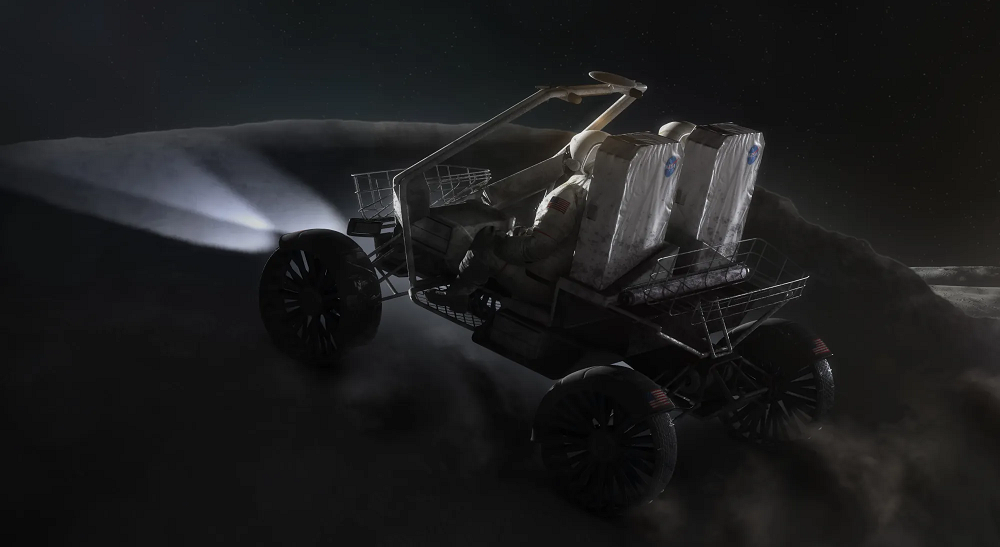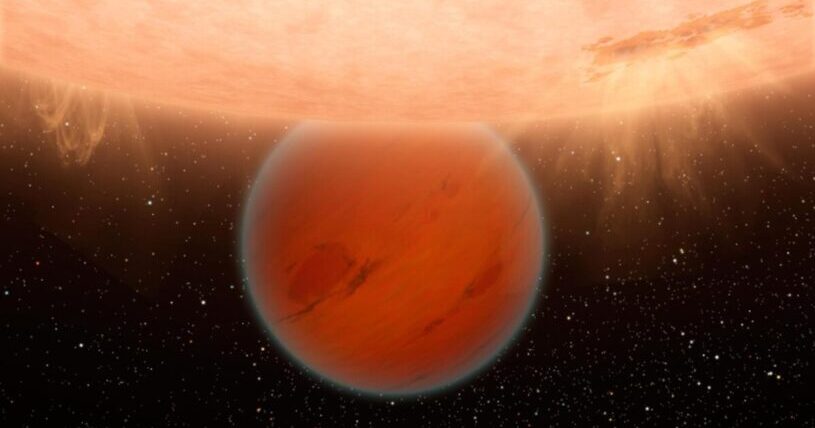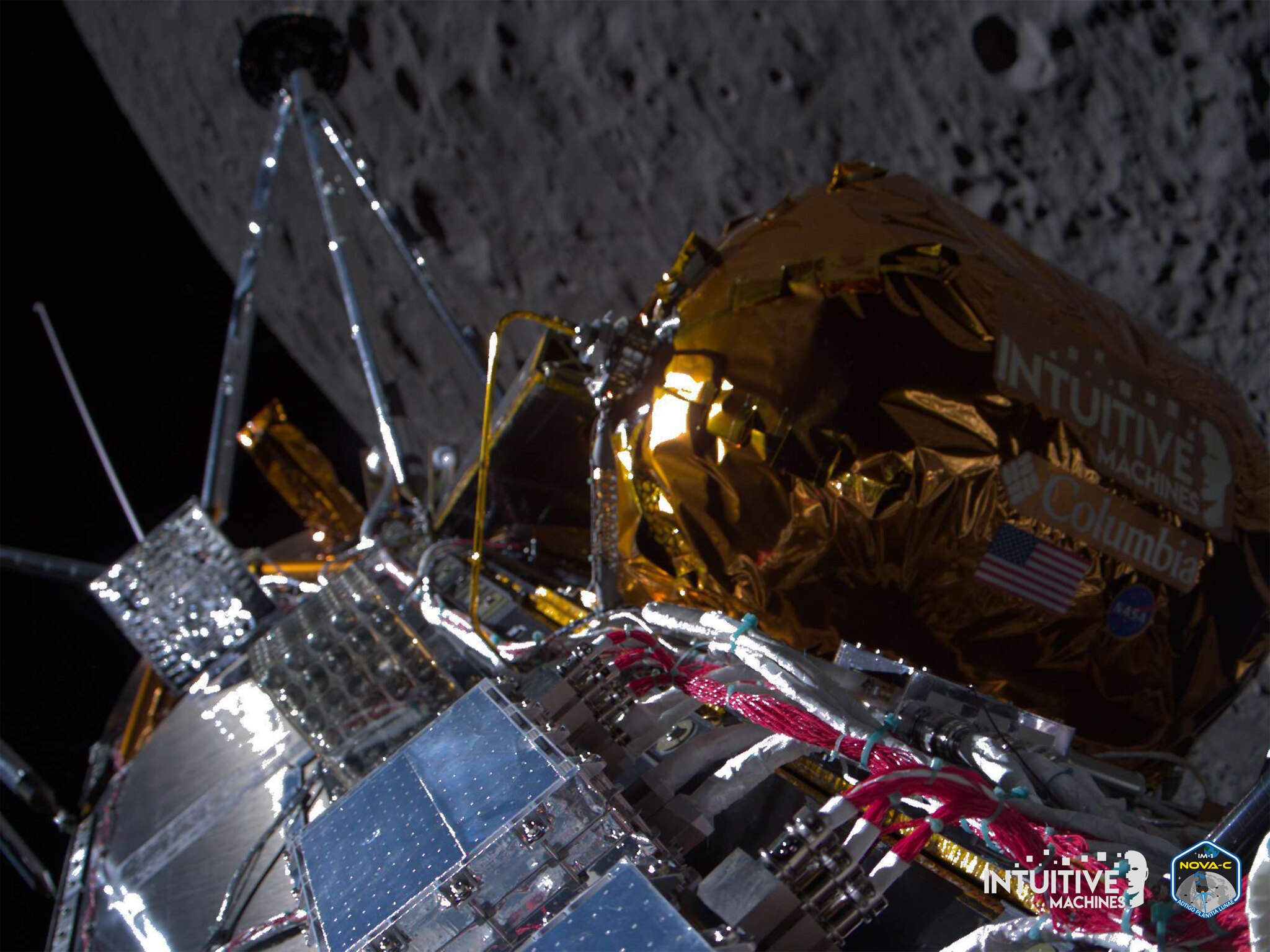Solar Cycle 25 Could Disrupt Satellites, Other Services, but Scientific Probes Are Providing New Data
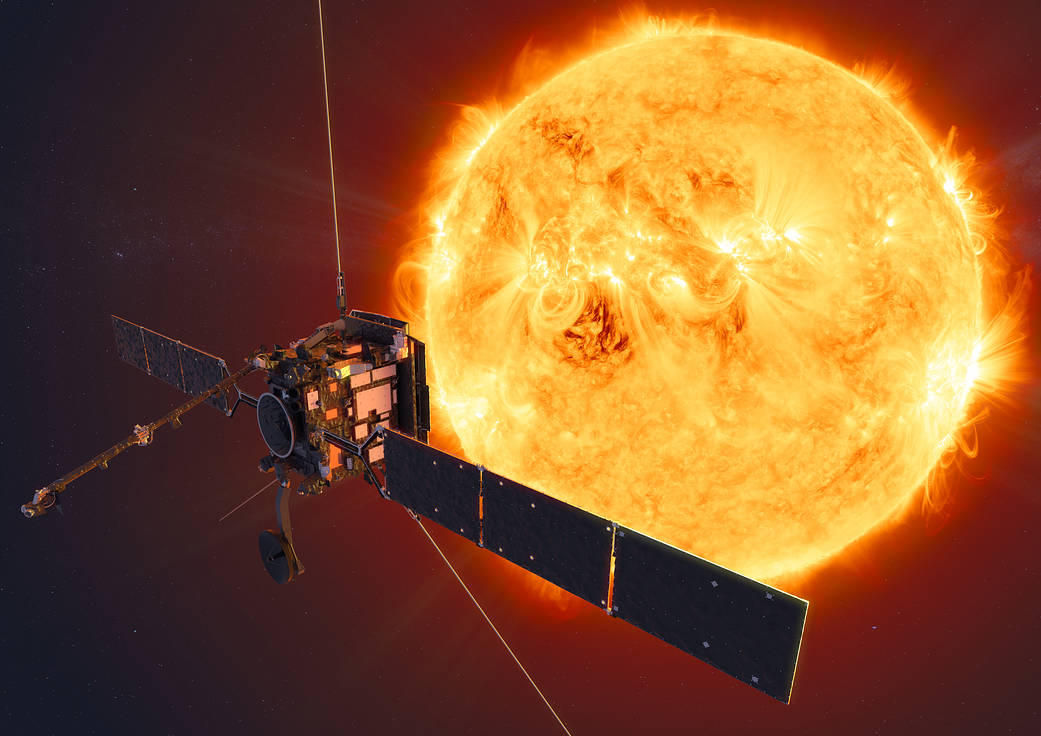 ESA’s Solar Orbiter mission, which has strong collaboration from NASA, launched in 2020 from Cape Canaveral. The mission is intended to increase understanding of how the Sun creates and controls the giant bubble of plasma that surrounds the whole Solar System and influences planets within it.
ESA’s Solar Orbiter mission, which has strong collaboration from NASA, launched in 2020 from Cape Canaveral. The mission is intended to increase understanding of how the Sun creates and controls the giant bubble of plasma that surrounds the whole Solar System and influences planets within it. 
The Sun lies at the center of our solar system and sets the cycle of our daily lives, yet so much remains unknown about how it functions. As the Sun enters into a years-long phase of increasing solar eruptions, its increased activity poses risks to thousands of Earth- and space-based infrastructure assets. The increased solar activity comes as probes from NASA, ESA, and China are gathering the most advanced data ever collected about Earth’s star.
The end of 2019 brought the beginning of Solar Cycle 25, which is expected to bring a solar maximum —the highest level of activity during an approximately 11-year solar cycle — in 2025. Analysis by a team from the National Center for Atmospheric Research predicts that the peak of this solar cycle may have as many as 230 disruptive sunspots — the highest rate since such activity began being recorded in 1749.1
From the standpoint of government and commercial industries, studying the patterns of solar activity is crucial for mitigating increased solar activity to better protect satellites, Earth-based systems and hardware, the International Space Station and astronauts on extravehicular activities (EVAs).

Nicola Fox, heliophysics division director in the Science Mission Directorate at NASA, explains that a massive solar event could impact the accuracy of GPS signals, wipe out satellite signals, or cause a widespread outage of a power grid. “As a society, we become more and more reliant on technology,” she said. “We are very susceptible to the vagaries of the sun.”2
One airline advocacy organization, Airlines for America, began preparing for the increased solar activity in 2021. Its A4A Meteorology Committee outlined collaboration needed between industry stakeholders to minimize risks of radio blackouts from degradation of high frequency radio communications on Earth’s sunlit side and possible elevated radiation exposure to crew and passengers from solar storms.3
Because solar storms are expected to happen with more frequency, it is vital to search out the “signatures that warn” in advance of their coming, Fox said. Studying the Sun also helps scientists learn more about the stars in other single and binary systems. By studying the radiation environment more closely than ever before, Fox says, the more scientists can predict and model solar activity to better protect Earth and its infrastructure. Even if everyone does not recognize it, the Sun is the cornerstone of daily life on Earth and in low Earth orbit (LEO).
Understanding Solar Activity
To better comprehend the importance of the Sun’s impact on Earth and the rest of the solar system, it is important to recognize some basic facts about the star around which everything relies. Just like Earth, the Sun is composed of a series of layers. Unlike Earth, however, the Sun’s outermost layer is not cooler than its core, it’s significantly hotter. The perennial coronal heating problem refers to the odd phenomenon of the outermost layer, the corona, boiling at more than 2 million degrees Fahrenheit (1.1 million degrees Celsius) while the underlying surface reaches only about 10,000 degrees Fahrenheit (5,537 degrees Celsius).4 This very contradiction continues to baffle scientists, because none of the existing theories solely explains the phenomenon. Nanoflare eruptions and Alfvén waves — tiny coronal eruptions and magnetic plasma waves — are two aspects of solar activity that solar probes are actively studying to explain the coronal heating anomaly.
The Sun’s 11-year process of reversing polarity is a generally predictable fluctuation of solar activity that scientists have recognized for decades. Because the Sun is about three years into the current cycle, sunspots are still relatively quiet. However, coming years should see an increase in solar activity, resulting in an overall increase of radiant energy the Sun produces and directs outward, including toward Earth. The cadence and intensity of solar eruptions also complement the change in sunspots, slowly getting stronger throughout the cycle as the Sun’s magnetic poles flip their polarity.
Although the solar cycle is largely consistent with overall temperature gradient trends, the Sun keeps many mysteries that scientists continue to explore. Because the Sun’s solar weather emanates in all directions, including toward Earth, it is becoming increasingly important to study solar eruptions.
Solar storms that are powerful enough to affect Earth are not recent occurrences, but modern scientists have improved the process of documenting them. The Carrington Event in 1859 was the biggest solar storm in recorded history. The sky lit up at 1 a.m., and the aurora borealis extended from near the northern pole all the way to the Caribbean. More recently, exceptionally powerful solar storms occurred in 1989 and 2003 that turned off regions of the Canadian electrical grid and damaged multiple satellites. On Bastille Day in July 2000, the Sun emitted an X-class storm, the highest designation of radiated particles, leading to radio blackouts and giving scientists an opportunity to learn how to operate instruments during an immense solar storm.
As humanity becomes more reliant on its electrical network, solar storms become less of a midnight spectacle and more of a dangerous liability. Improved study of the Sun’s activity will allow scientists to better predict such occurrences and appropriately shut off power grids or enable improved capacitors to absorb the sudden input of solar energy. There is added risk in space, too. Astronauts performing EVAs are exposed to a vast amount of solar radiation while outside the International Space Station. Predicting large coronal mass ejections (CMEs) beforehand can help space agencies plan EVAs around any such solar storms to protect their astronauts.5
NASA’s Artemis missions to return humanity to the Moon is the next big step to landing people on Mars. NASA, Fox said, has identified that predicting changes in the solar environment is an integral part of protecting manned missions.
If solar storms do not always impact Earth’s infrastructure, then why are they so important to study? There are more than 3,000 satellites in low Earth orbit (LEO).6 Every time the Sun emits a high-impact storm of charged particles, it can “hide” a satellite from view, including from the U.S. Space Surveillance Network (SSN), which uses radar to locate items larger than four inches in orbit around Earth. After a large solar storm, such as the one in October 2003, the SSN’s radar can be disrupted, and the position of hundreds of satellites can be temporarily lost. If the Earth were to be hit with another solar storm of this magnitude, the satellite network could be lost for weeks, which would throw Earth communications into chaos.7
The dynamic processes of the Sun have led to interesting and unprecedented effects in Earth’s atmosphere. The European Space Agency (ESA) noticed in 2021 that its Swarm constellation of satellites was losing altitude up to 10 times faster than usual and attributes the change to increased atmospheric drag caused by solar wind and related activity.8 The increased solar activity since this incident has caused the mass of particles in the upper atmosphere to also increase, which forces satellite operators to course correct more often.9 Months after ESA’s Swarm announcement, SpaceX lost 40 Starlink satellites after they were hit by a solar storm a day after launch.10
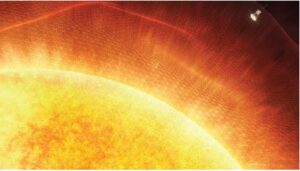
The Parker Solar Probe gathered new scientific data as it became the first instrument to enter the Sun’s atmosphere. Watch this NASA video to see five new discoveries from the Parker Solar Probe.
Credit: NASA/Johns Hopkins APL
Solar Probes
Astronomers have a variety of tools that they use to study the Sun. There are 19 active National Aeronautics and Space Administration (NASA) missions that study the Sun and interplanetary space, all carrying a variety of scientific instruments to gather solar data.11 Hinode, Parker Solar Probe, and Solar Orbiter have collected some of the most advanced data leading to new scientific understanding of the Sun. In October, China launched ASO-S, its first observatory dedicated to solar research. Each probe has a unique set of instruments designed to examine a specific aspect of the Sun and its atmosphere.
The Parker Solar Probe (PSP) launched in 2018 on a ballistic trajectory to use flybys of Venus to approach the Sun at the closest any spacecraft has yet come.12 It only took a mere three months before it entered the Sun’s heliosphere, where it is allowing scientists to study the origin of solar wind.13 In December 2021, the Parker probe crossed into and out of the corona several times to provide new information about the shape and texture of the coronal environment.14 PSP has 24 planned elliptical orbits that will take it close to the Sun and out closer to Venus, and Fox hopes it could have an extended mission beyond those 24 planned perihelion approaches.
In contrast to Parker Solar Probe, Solar Orbiter carries a larger payload consisting of 10 instruments. Six of these instruments perform sensory and imagery tests, and the other four detect solar particles.15Solar Orbiter primarily studies solar wind and solar eruptions, which will ultimately help build reliable satellite systems that are more immune to the Sun’s dynamic magnetism.16 Solar Orbiter in October captured the highest-resolution images of the Sun’s quiet corona. On March 30, Solar Orbiter’s Extreme Ultraviolet Imager (EUI) took an image at a wavelength of 17 nanometers, capturing the magnetic loops and color differentials that indicate where gases are released into space. Solar Orbiter’s primary perihelion, where it will pass by the Sun at just 0.28 AU, will occur in 2027.17 Solar Orbiter is another joint mission between ESA and NASA but is primarily led by ESA.
Hinode, a satellite launched in 2006, is helping scientists understand solar activity by examining the Sun in X-rays, visible light, and ultraviolet light.18 These particular wavelengths can pierce through the mass particles released by the Sun, opening a new world of visibility. The satellite consists of two telescopes and a spectrometer that allow it to observe its surroundings.19 Hinode studies the magnetic energy of the photosphere and corona, and how they affect interplanetary space.20Hinode is a mission led by the Japan Aerospace Exploration Agency’s Institute of Space and Astronautical Science (JAXA) but is a collaborative effort between Japan, the United States, the United Kingdom, and Europe.
China’s Advanced Space-based Solar Observatory (ASO-S), nicknamed Kuafu-1, is the country’s first solar satellite solely studying the Sun. ASO-S is designed to collect data for four years with its three onboard instruments. The probe will be the world’s first satellite to image the Sun’s heliosphere and corona at the same time. China designed ASO-S to complement ESA’s existing Solar Orbiter. When the data is combined, scientists will be able to view a stereoscopic view of solar flares, allowing further understanding into directional radiation.21 Additionally, ASO-S also provides a complementary picture of the Sun from what Parker Solar Probe views. Because PSP is the closest probe to the Sun’s surface, it cannot directly view the Sun but rather detects local particles and solar wind. ASO-S can view the Sun directly with its telemetry and remote sensing capabilities.22
The most current technology launched toward the Sun is a CubeSat weather station that was part of the Artemis I mission. The CubeSat to study Solar Particles (CuSP) will orbit the Sun to study solar flares and auroras with its three scientific instruments.23Putting such a piece in orbit will allow scientists to gather more detailed information about solar weather, and to observe extreme solar events to give warning before such events hit Earth.
Not only do these tools help scientists understand the Sun, but scientists have become very creative at using the same tools to also observe other phenomena. For example, the Parker Solar Probe (PSP) snapped the first optical images of Venus as it passed through its gravitational assists. Because PSP’s flight plan included seven gravity assist flybys (VGA) to achieve the closest possible perihelion of its solar orbit, the Wide-Field Imager for Solar Probe (WISPR) was used to image Venus as it passed by through the first five flybys. During the 2021 flyby, PSP took the first visible light images of Venus’ surface on the planet’s night side.24 PSP’s final flyby will take place in November 2024.25 Another example of PSP providing extra-solar science is from its gaze at a meteor shower in December 2019. It was able to get a far-off glance at the Geminid meteor stream, providing insight into its association with the asteroid Phaethon26
While there are many different probes studying the Sun, each has a unique payload that allows it to “see” the Sun in a different wavelength. Therefore, each can detect different aspects of the Sun’s composition that allow scientists to view a more comprehensive picture of Earth’s star.

Anna Shaw is a program manager at Space Foundation Discovery Center where she implements and facilitates a range of public programs such as Small Steps, Giant Leap, Homeschool Days, Family Star Party, and Tesla’s Toolbox. Email her at ashaw@spacefoundation.org.
Of Nearly Two Dozen Active Solar Missions, These Three Provide The Most Insight Into The Sun
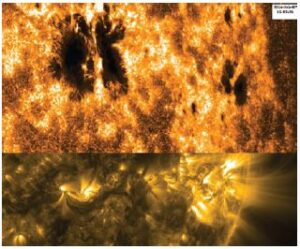
Hinode
Launch: September 2006
Organization: JAXA
Mission Objective: To study the Sun’s magnetic field and how it impacts solar eruptions
Instruments on board: Solar Optical Telescope, EUV Imaging Spectrometer, X-Ray Telescope
Status: Recently discovered the source origin of three tracked Solar Energy Particles (SEP) from the Sun’s magnetic fields.
Image: Hinode views sunspot activity from active region 11967 in 2014.27
Credit: NASA/JAXA/Lockheed Martin
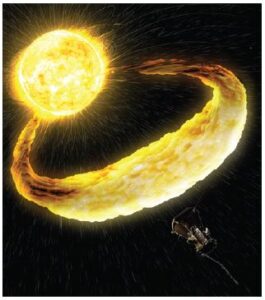
Parker Solar Probe
Launch: August 2018
Organization: ESA/NASA Mission
Objective: To fly closer to the Sun than any other instrument to observe the birth of the most highly energetic particles and how they impact solar wind.
Instruments on board: Wide-Field Imager for Parker Solar Probe (WISPR), Solar Wind Alphas and Protons investigation (SWEAP), Solar Probe Cup (SPC), Solar Probe Analyzers (SPAN), Energetic Particle Instrument Hi (EPI-Hi), Energetic Particle Instrument Lo (EPI-LO)
Status: Recently imaged the surface of Venus in visible light – the first image of its kind.
Image: Magnetic switchbacks, shown in this illustration, are among the first discoveries credited to the Parker Solar Probe. The role of waves in heating solar plasma, solar angular movements and the near-Sun dust-free environment are other discoveries.28
Credit: NASA/Johns Hopkins APL.
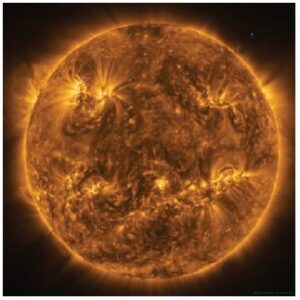
Solar Orbiter
Launch: February 2020 Organization: ESA/NASA Mission
Objective: To study the origin and extent of the heliosphere (a cocoon of charged particles) that envelopes and extends beyond the Solar System.
Instruments on board: Energetic Particle Detector Suite (EPD), Magnetometer (MAG), Solar Wind Analyzer Suite (SWA), Polarimetric and Helioseismic Imager (PHI), Solar Orbiter Heliospheric Imager (SoloHi), Spectral Imaging of the Coronal Environment (SPICE), X-Ray Spectrometer/Telescope (STIX)
Status: Recently took a stunning video of comet Leonard streaking across the sky, with Venus, Mercury, and the Milky Way in the background.
Image: The highest-resolution photo of the Sun to date, taken in March.29
Credit: ESA/NASA
- McIntosh, ScottW.; Chapman, Sandra; Leamon, Robert J.; Egeland, Ricky; Watkins, Nicholas W.; “Overlapping Magnetic Activity Cycles and the Sunspot Number: Forecasting Sunspot Cycle 25 Amplitude.” Solar Physics. 2020. https://doi.org/10.1007/s11207-020-01723-y. Accessed Dec. 4, 2022.
- Fox, Nicole, Personal Interview, Sept. 8, 2022.
- Polderman, Nathan. “Airline Industry Preparations for Solar Cycle 25.” Airlines for America. April 21, 2021. https://www.swpc.noaa.gov/sites/default/files/images/u63/05.%20Polderman_Space%20Weather%20and%20Airlines%20for%20America.pdf. Accessed Dec. 4, 2022.
- NASA. “NASA’s Parker Solar Probe and the Curious Case of the Hot Corona.” July 27, 2018. https://www.nasa.gov/feature/goddard/2018/nasa-s-parker-solar-probe-and-the-curious-case-of-the-hot-corona. Accessed June. 10, 2022.
- Nicitopoulos, Theo. 2022. “Storms from the Sun.” Discover, 43(2): 16. Accessed May 19, 2022.
- “Every Satellite Orbiting Earth and Who Owns Them.” Dewesoft. Jan. 18, 2022. https://dewesoft.com/daq/every-satellite-orbiting-earth-and-who-owns-them. Accessed June 10, 2022.
- Pultarova, Tereza. “Satellites Can Disappear in Major Solar Storms and It Could Take Weeks to Find Them.“ Space.com. July 26, 2022. https://www.space.com/satellites-lost-after-solar-storms-for-weeks. Accessed June 10, 2022.
- Pultarova, Tereza. “Wild Solar Weather is Causing Satellites to Plummet from Orbit. It’s Only Going to Get Worse.” Space.com. June 23, 2022. https://www.space.com/satellites-falling-off-sky-solar-weather. Accessed June 10, 2022.
- Pultarova, Tereza. “Wild Solar Weather is Causing Satellites to Plummet from Orbit. It’s Only Going to Get Worse.”
- Pultarova, Tereza. “Wild Solar Weather is Causing Satellites to Plummet from Orbit. It’s Only Going to Get Worse.”
- NASA. “Heliophysics Missions: Studying the Sun and its Effects on Interplanetary Space.“ https://www.nasa.gov/mission_pages/sunearth/missions/index.html. Accessed June 10, 2022
- Thompson, Paul, et al. “Parker Solar Probe Navigation: One Year from Launch.” 2017. California Institute of Technology. Accessed June 10, 2022.
- Dudok de Wit, et al. “First Results from the SCM Search-Coil Magnetometer on Parker Solar Probe.” 2022. JGR Space Physics. Accessed May 20, 2022.
- NASA. “Amazing Achievements from Parker Solar Probe.” https://blogs.nasa.gov/parkersolarprobe/2022/04/29/amazing-achievements-from-parker-solar-probe. Accessed Sept. 18, 2022.
- NASA. “Solar Orbiter Instruments.” 2021. https://www.nasa.gov/content/solar-orbiter-instruments. Accessed Sept 18, 2022.
- NASA. “Solar Orbiter Science.” 2021. https://www.nasa.gov/content/solar-orbiter-science. Accessed Sept 18, 2022.
- ESA. “Solar Orbiter.” https://www.esa.int/Science_Exploration/Space_Science/Solar_Orbiter. Accessed June 9, 2022.
- Harvard & Smithsonian. “Hinode.” Center for Astrophysics. https://www.cfa.harvard.edu/facilities-technology/telescopes-instruments/hinode. Accessed June 9, 2022.
- Kosugi, T. et al. “The Hinode (Solar-B) Mission: An Overview.” Solar Physics, 243: 3-17. Sept. 12, 2007.
- NASA. “Hinode.” .” https://www.nasa.gov/mission_pages/hinode/index.html. Accessed May 20, 2022.
- Gibney, Elizabeth. “China’s First Solar Observatory Aims to Solve Mysteries of the Sun’s Eruptions.” Nature.com. Oct. 7, 2022. https://www.nature.com/articles/d41586-022-03180-y. Accessed Nov. 18, 2022.
- CGTN. “Why did China Launch Another Solar Probe When There are Dozens in Space?” Oct. 9, 2022. https://news.cgtn.com/news/2022-10-09/Why-China-launched-another-solar-probe-when-there-are-dozens-in-space-1dZOeJRacgg/index.html. Accessed Nov. 18, 2022.
- Waldek, Stefanie. “Artemis I Will Carry a Space Weather Cubesat to Study Solar Wind.” Space.com. Aug. 22, 2022. https://www.space.com/artemis-1-moon-mission-cusp-cubesat-space-weather. Accessed Sept. 22, 2022.
- Johnson-Groh, Mara. “Parker Solar Probe Captures its First Images of Venus’ Surface in Visible Light, Confirmed.“ NASA. Feb. 9, 2022. https://www.nasa.gov/feature/goddard/2022/sun/parker-solar-probe-captures-its-first-images-of-venus-surface-in-visible-light-confirmed. Accessed May 21, 2022.
- Wood, et al. “Parker Solar Probe Imaging of the Night Side of Venus.” Geophysical Research Letters, 48. 2021. Accessed May 20, 2022.
- Temming, M. ”Parker Probe Spies on Meteor Shower.” Science News, 2020. vol. 197, no. 1, p. 6, Accessed August 25, 2022. Accessed May 19, 2022.
- NASA. “Hinode.” https://www.nasa.gov/mission_pages/hinode/index.html. Accessed Sept 18, 2022.
- NASA. “Parker Solar Probe.” https://www.nasa.gov/content/goddard/parker-solar-probe. Accessed Sept 18, 2022.
- NASA. “Solar Orbiter.” https://www.nasa.gov/solar-orbiter. Accessed Sept 18, 2022.

